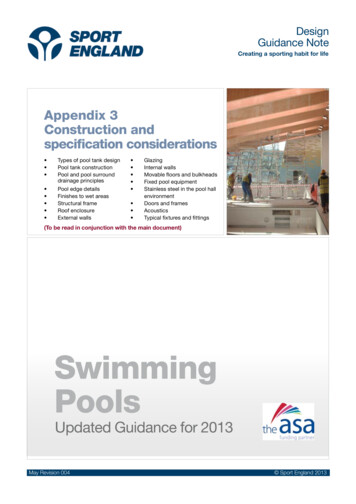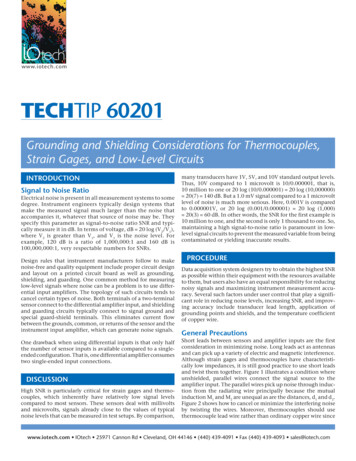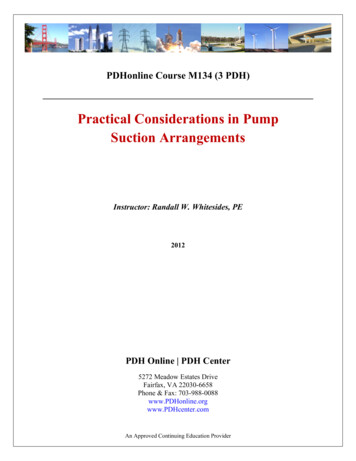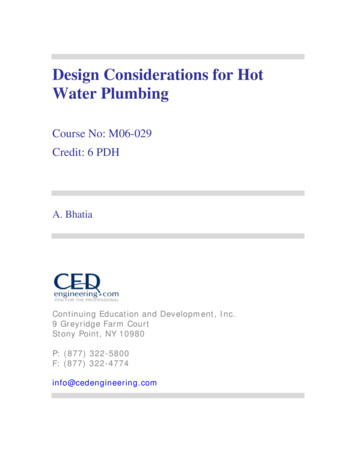
Transcription
Important Considerations for Refractory Dryouts, Startups & Shutdowns2011 Sulfur Recovery Symposium in Vail, CO.—Brimstone STS Limited—September 13-16, 2011Important Considerations for Refractory Dryouts, Startups& ShutdownsByJim Jenkins, Shell International Exploration and Production, Houston, TexasAndy Piper, THORPE – Refractory Engineering and Services, Houston, TexasJeff Proctor, P.E., THORPE – Refractory Engineering and Services, Houston, Texas(www.ThorpeECGroup.com)AbstractSignificant changes in temperature can have catastrophic effects on refractory systems. The term“significant”, however, is highly dependent upon the particulars of the lining system and the materialsutilized.In today’s business climate with the strong push to get units back into service as a result of budgetconstraints and economic drivers, oftentimes little consideration is given to furnace heat up rates that willprevent damage to the refractory linings. This has sometimes led to refractory failure before reachingnormal operating conditions or premature deterioration of lining systems leading to unexpected, timeconsuming repairs required before or during scheduled outages. One cannot fault a calculated risk, forbusiness reasons, to get a unit back into production, but many times these decisions are made by those noteven aware they are exposing a piece of equipment to any abnormal risk.In the first part of this paper we will present information to better explain when there is a need for arefractory dryout and the critical aspects that affect and determine the dryout schedule; we will discuss thedifferences between two common types of dryout schedules; and we will review the thermal andmechanical issues involved in a normal startup/shutdown outside of any dryout needs.In the second part of the paper we will address some of the real world issues or problems involved inexecuting the required dryout/startup/shutdown schedules with different equipment configurations. Aftera discussion of the various concerns and equipment restrictions, we will consider some techniques thathave been utilized in operating plants to allow for better dryout/startup/shutdown temperature control inorder to reduce damage to the refractory lining system.Refractory DiscussionRefractory dryout is the controlled process of applying heat to a refractory lining to remove water fromthe lining system without causing damage to the refractory materials. Whenever linings are heated upfrom ambient temperatures, whether it be the initial heatup after a new lining installation or a subsequentheatup of an existing lining after an outage, heatup procedures, ramp rates and hold points should alwaysbe thoroughly discussed and agreed upon by the owner, lining designer, lining installer, refractorymanufacturer and dryout subcontractor.Page 1 of 15
Important Considerations for Refractory Dryouts, Startups & Shutdowns2011 Sulfur Recovery Symposium in Vail, CO.—Brimstone STS Limited—September 13-16, 2011This paper is intended to present general information to help industry operation personnel betterunderstand the critical points and concerns of a typical dryout without delving into all of the possiblebond phases and chemical water release points that can be identified by refractory ceramic engineers. Wewill focus on the conventional, cement based castables as their use is most common in sulfur recoveryunits. Conventional castable materials cover a very wide range of products; from very lightweight (25lb/ft3) to very dense (170 lb/ft3), with numerous possibilities for the cement binders and product mixes.Please note that many of the figures stated in this paper represent only average or order of magnitudenumbers in order to not get bogged down in countless options and variables that would be of moreimportance to specific materials and installation parameters associated with an actual project.DefinitionsTo clarify some misused or misunderstood terminology in the industry, let us start with some definitions: Curing – The cement bonding process that takes place within the castable material (cement aggregate) after the dry components are mixed with water and either poured or gunited into place.The water and cement then react to form a strong bond with the aggregate at ambienttemperatures, normally occurring in the first 24-48 hours after placement.Dryout - The initial application of heat under controlled rates to safely remove retained free andchemically combined water from the refractory lining after completion of the curing process.Free or Physical Water – Excess water remaining in the castable material pores after installation.This is the portion of the water that does not react with the cement and will boil off at normaltemperatures as free water.Chemically Combined Water – Water that is tied up in the cement hydrate phases (bondstructure). This water does not boil off at 212ºF as does free water, but is released in stages atelevated temperatures.Water Ratios (Free vs. Chemical)Let us begin by better understanding free/chemical water ratios in castables. On average, conventionalcastable products require about 25% of the total water added to the dry castable mixture to hydrate thecement in order to form the expected bond structure. As already noted, this is defined as the chemicallycombined water. The other 75% of the water added is required to facilitate material placement(flowability, compaction and de-airing). The type of product, type of cement and other additives in acastable mix can affect these percentages. One significant factor, often overlooked, that can impact theamount of chemically combined water contained within the castable is the ambient temperature at whichthe curing process takes place. Low curing temperatures (below manufacturer’s suggested guidelines)can result in the formation of certain gel (bond) phases that can complicate a normal dryout schedule. Tofurther explain: In a typical castable dryout, the free water first boils off when temperatures reach 212 F.The boiling off of this free water creates porosity within the matrix. The more free water, the higher theporosity of the castable material. It is this porosity which facilitates the removal of the chemicallycombined water that is released at higher temperatures. Some gel phases result in a higher percentage ofwater than normal being tied up in the cement (chemically combined water). The net effect is that morewater has to be driven off at higher temperatures and this water also has to be forced thru a bond matrixthat is less permeable than normal for the same product. The bottom line then is that linings cured at lessPage 2 of 15
Important Considerations for Refractory Dryouts, Startups & Shutdowns2011 Sulfur Recovery Symposium in Vail, CO.—Brimstone STS Limited—September 13-16, 2011than ideal temperatures will require a longer than normal dryout schedule with reduced ramp rates andadditional or longer hold points. This can actually be a significant increase in total dryout schedule time.The refractory manufacturer should therefore always be consulted as to the proper refractory placementand curing temperatures in advance of the lining installation so that environmental controls can beinitiated if necessary. If linings are installed or cured at lower than the recommended limits, thisinformation should also be relayed to the material manufacturer when requesting the dryout schedulerecommendation.Importance of PermeabilityType Materal3LowCementType of Refractory ra-lightInsulatingDensity (lb/ft )140-180130-170100-13030-10020-30Water Content %4-88-1215-1820-4040 Permeability(after air cure)LeastMostWater releaseissuesMore difficultLessdifficultThe simple table above helps to illustrate the importance of permeability in refractory dryouts. In general,decreasing density relates to increased water content and therefore typically higher permeability.Realizing that the volume difference from water to steam is 1600X, any restriction of the water/steamremoval from the lining will build pressure within the lining system.To consider the extremes, a completely permeable lining will prevent (steam) pressure buildup with theresult that there would be no dryout concerns, as steam spalling cannot occur without the formation ofsteam pressure regardless of the amount of water. At the opposite extreme, a completely impermeablematerial will not allow any steam to pass thru; the integrity of the lining being limited by its ability tocontain the buildup of steam pressure within. In an actual lining, even a little water highly restricted candevelop pressures that exceed the strength of the refractory material resulting in significant damage fromexplosive spalling. Permeability of the lining is therefore a significant key to the criticality of the dryout.Understanding Thermal ProfilesEveryone realizes that water boils at 212 F. Chemically combined water is released at various elevatedtemperatures, sometimes as high as 900 F, depending on the types of cement phases formed during thecuring process. For many castable materials, a common critical water release point (due to the volume ofchemical water being released) occurs within a range of 400 -600 F. By thinking through the entireprocess, one begins to realize the complexity of the problem. Most thermal measurements are taken at thehot face of the refractory. The chemical water is released at progressively greater depths within the liningas the lining is heated up. When castable materials are used as backup linings in thermal reactors, thewater commonly extends very deep in the lining going all the way to the steel shell and has to be drivennot only through castable but also the hot face brick lining. The bricks utilized in reaction furnacestypically have very low permeability. Dryout schedules must account for the constantly changing thermalPage 3 of 15
Important Considerations for Refractory Dryouts, Startups & Shutdowns2011 Sulfur Recovery Symposium in Vail, CO.—Brimstone STS Limited—September 13-16, 2011profile thru the lining to assure temperatures do not ramp too fast through a critical temperature rangedeep inside the lining and that proper time is allowed for the steam to work its way through and out of thelining without increasing steam pressure greater than the lining can contain. Further complicating thesecalculations is that the free water still in the pores of the unfired material affects it’s thermal conductivity.To illustrate some of the dynamics, one of the projects we are currently involved in is utilizing a threecomponent lining. The specified lining includes 9” 90% brick on the hotface; a 3” intermediate layer ofof a high temperature, dense castable; and 3” of insulating castable against the shell. This is a fairly largereaction furnace in which this design results in a total of 2500 gallons of water added to the two layers ofcastable behind the dense, low porosity hotface brick. The graphic and table below illustrate the effect ofthe thermal profile through this lining as various water release points are obtained at different pointsinside the lining. The following calculations are for illustration only, are based upon steady state andutilize thermal conductivity factors of fired samples. An initial dryout is much more dynamic withchanging K-factors and transient heat flow as water is driven off and temperatures are increased. Fordiscussion purposes, we are assuming 212ºF for free water release and an average of 500ºF for chemicalwater release.Inside GasTemperature F600ºF1000ºFMean Temperatures of Refractory LayersHot Face ºFIntermediate ºFBackup hell ºF115125133141149156162168175223Thermal Profile ChartsAs one can see in the Thermal Profile Chart above, this lining will have both free and chemicallycombined water being released at the same time at different depths within the lining. Critical dryoutssuch as these may use external and/or buried thermocouples to evaluate and better understand what isgoing on within the lining. As mentioned earlier, as water is removed from the lining during the dryoutthe insulating properties of the material changes. This can be monitored by tracking changes in shelltemperature particularly during an internal hold period.Complex LiningsComplex linings include different lining configurations within the same unit. This can mean a change inmaterial quality and/or thicknesses. Thickness changes can be as important as material changes due to thechanges in water volume and the thermal profile through the different lining thicknesses resulting indifferent water release points at the different measured hotface temperatures. All of these scenarios needPage 4 of 15
Important Considerations for Refractory Dryouts, Startups & Shutdowns2011 Sulfur Recovery Symposium in Vail, CO.—Brimstone STS Limited—September 13-16, 2011to be considered in determining a final dryout schedule that accounts for all critical points in the entirelining system to be fired.Essential PartiesProjects are structured differently from job to job. From major new construction to minor repairs; fromthe design, supply and installation of the lining split between 2 or three different companies or allcombined into a single contract. Assuming a new construction project with newly designed linings, wewould recommend the following structure in regard to the dryout plan and responsibility.1. Refractory Designer – Must provide the refractory material manufacturer with essentialinformation such as various lining compositions, material thicknesses and maximum dryouttemperature for the lining.2. Refractory Material Manufacturer – Responsible for determining the appropriate dryout schedulebased on information provided by the Refractory Designer and adjusted based upon informationprovided by the Refracto
04.11.2015 · order to reduce damage to the refractory lining system. Refractory Discussion Refractory dryout is the controlled process of applying heat to a refractory lining to remove water from the lining system without causing damage to the refractory materials. Whenever linings are heated upFile Size: 576KBPage Count: 15











